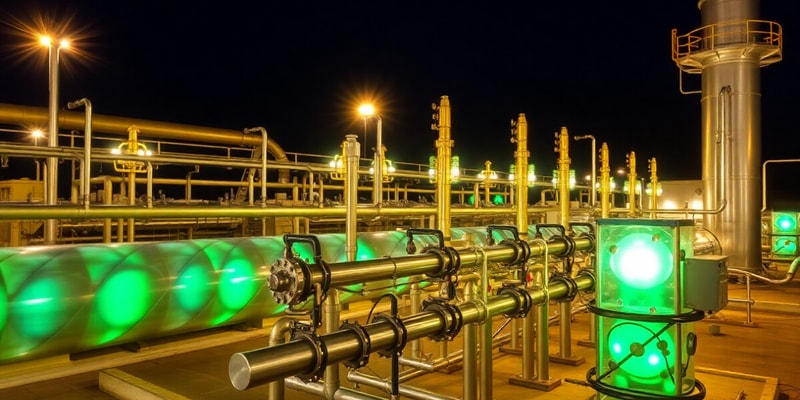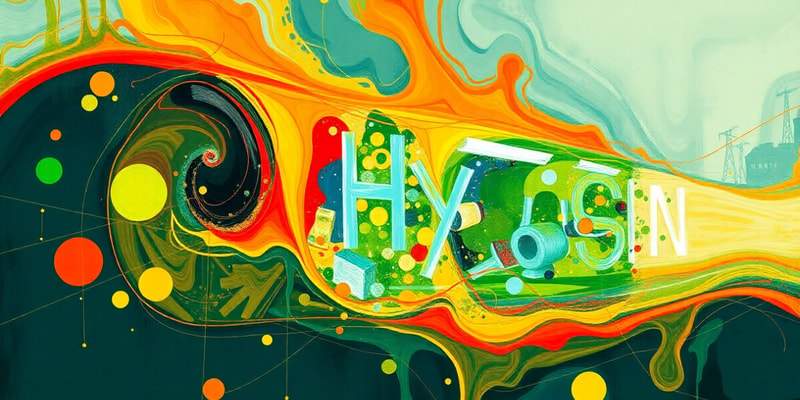Podcast
Questions and Answers
What is the primary focus of Lecture 14?
What is the primary focus of Lecture 14?
Grey hydrogen is produced without any carbon capture technology.
Grey hydrogen is produced without any carbon capture technology.
True
Name one application of hydrogen utilization mentioned.
Name one application of hydrogen utilization mentioned.
Fuel cells
The process of converting methane into hydrogen is known as __________.
The process of converting methane into hydrogen is known as __________.
Signup and view all the answers
Match the hydrogen types with their production characteristics:
Match the hydrogen types with their production characteristics:
Signup and view all the answers
Which option best describes blue hydrogen?
Which option best describes blue hydrogen?
Signup and view all the answers
H₂ blending refers to adding hydrogen to the existing natural gas pipeline.
H₂ blending refers to adding hydrogen to the existing natural gas pipeline.
Signup and view all the answers
What authority does Dr. Lourdes F. Vega hold?
What authority does Dr. Lourdes F. Vega hold?
Signup and view all the answers
What is the method used to produce grey hydrogen?
What is the method used to produce grey hydrogen?
Signup and view all the answers
Blue hydrogen is produced using fossil fuels with carbon capture technology.
Blue hydrogen is produced using fossil fuels with carbon capture technology.
Signup and view all the answers
What is a key application of hydrogen utilization?
What is a key application of hydrogen utilization?
Signup and view all the answers
The process of capturing CO₂ during hydrogen production is a characteristic of __________ hydrogen.
The process of capturing CO₂ during hydrogen production is a characteristic of __________ hydrogen.
Signup and view all the answers
Match the types of hydrogen with their source of production:
Match the types of hydrogen with their source of production:
Signup and view all the answers
Which type of hydrogen is typically blended into existing natural gas pipelines?
Which type of hydrogen is typically blended into existing natural gas pipelines?
Signup and view all the answers
Natural gas reforming is a method used for hydrogen production.
Natural gas reforming is a method used for hydrogen production.
Signup and view all the answers
What role does Dr. Lourdes F. Vega serve in the context of the lecture?
What role does Dr. Lourdes F. Vega serve in the context of the lecture?
Signup and view all the answers
Hydrogen is often utilized as a chemical __________ in various industrial processes.
Hydrogen is often utilized as a chemical __________ in various industrial processes.
Signup and view all the answers
What is the significance of the Research and Innovation Center on CO2 and Hydrogen?
What is the significance of the Research and Innovation Center on CO2 and Hydrogen?
Signup and view all the answers
Study Notes
Hydrogen Supply Chain
- Production: Grey hydrogen is generated from natural gas through steam methane reforming. Blue Hydrogen involves CO₂ capture during the reforming process.
- Transportation: Involves pipeline networks, trucks, or ships. Can also be transported as a blend in natural gas pipelines.
- Utilization: Hydrogen can be used in various applications including chemical feedstock, Combined Cycle Power Plants (CCPP) with Carbon Capture, Storage, and Utilization (CCS⁴), engines, fuel cells, refineries, and for production of E-fuels.
- Storage: Is an essential component in the hydrogen economy, enabling the distribution of hydrogen when demand exceeds production.
Hydrogen Supply Chain
- The lecture was on Hydrogen storage options, focusing on underground hydrogen storage as a part of the larger hydrogen supply chain.
- The hydrogen supply chain consists of hydrogen production, transportation, and utilization.
- Hydrogen production methods include grey hydrogen (produced from natural gas with CO2 emissions), blue hydrogen (produced from natural gas with CO2 capture), and green hydrogen (produced through electrolysis using renewable energy).
- Hydrogen utilization methods include chemical feedstock, power generation (CCPP with CCS), engines, fuel cells, hydrogen-blended pipelines, and refinery energy applications.
- The lecture was delivered on October 10th, 2024 by Dr. Lourdes F. Vega, Professor at the Chemical and Petroleum Engineering Department at the university.
- Dr. Vega is the Director of the Research and Innovation Center on CO2 and Hydrogen (RICH Center).
- The lecture also included an invited speaker, Mr. Abdelateef Adam, a PhD student in the Chemical and Petroleum Engineering Department.
Studying That Suits You
Use AI to generate personalized quizzes and flashcards to suit your learning preferences.




